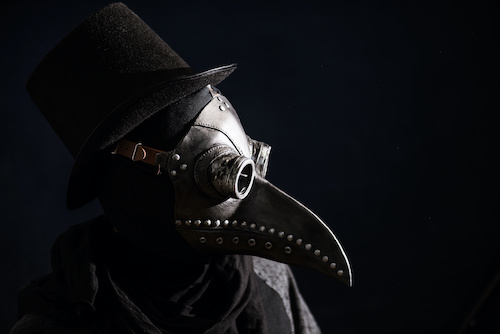Death Masks & Funeral Customs
 The wearing of masks has become compulsory for everyone who wants to protect themselves from the Coronavirus pandemic (or otherwise go out in public). So, as you mull over which type of facial covering to don, consider this. People have worn death masks for centuries. They protect people from diseases, demons, wartime side effects, and to guard against dental injury while playing sports. What’s more, death masks have long played an important role in many cultures since ancient times. Depending on the culture, masks have served myriad purposes. But in most cases, the masks used were anthropomorphic.
The wearing of masks has become compulsory for everyone who wants to protect themselves from the Coronavirus pandemic (or otherwise go out in public). So, as you mull over which type of facial covering to don, consider this. People have worn death masks for centuries. They protect people from diseases, demons, wartime side effects, and to guard against dental injury while playing sports. What’s more, death masks have long played an important role in many cultures since ancient times. Depending on the culture, masks have served myriad purposes. But in most cases, the masks used were anthropomorphic.
Death Masks
Death masks covered the face of the deceased. And their purpose was to honor the one who died. However, people wore masks to help the deceased establish a relationship with the spiritual world. In fact, in some cultures, people used masks to help the spirit of their beloved reach the spiritual world. While for other cultures, the mask helped to protect the deceased by warding off evil spirits.
Death Masks in Ancient Times
 Some of the most splendid death masks belonged to Egyptian royalty. However, every corpse in Ancient Egypt wore a mask.
Some of the most splendid death masks belonged to Egyptian royalty. However, every corpse in Ancient Egypt wore a mask.
- Egyptians buried Tutankhamen in the 14th century BCE. People made the spectacular death mask out of gold. Today, you can see it in the Egyptian Museum in Cairo.
- People covered the faces of ancient Greeks, Cambodians, and Siamese kings with gold masks before burial. Find one example in a Mycenean tomb, made of beaten gold.
- In ancient Rome, an actor wore a mask resembling the deceased. The mask-cloaked thespian accompanied the funeral cortege to the burial. People preserved the masks as portraits they displayed on special occasions.
Death Masks of the Central and Southern America
- Inca royalty wore golden masks when buried. Whereas lesser-known people were clad with masks made from wood or clay.
- Andean masks have been discovered with moveable parts. One such mask was discovered in the Temple of the Moon at Moche, Peru. It had moveable ears.
- In Mexico, death masks differed from the features of the deceased. They were designed as generic representations of the person who died.
- The Aztecs had skull masks which were inlaid with turquoise or lignite mosaics. The eye sockets featured pyrites. People either wore or hung them.
Europe in the Middle Ages and Beyond
 During the Middle Ages and up to the 18th century, European nobility revived the technique used by the ancient Romans. They cast death masks of the deceased in wax. People finished the masks with painted and applied human hair. They also positioned them on dummies dressed in state regalia for processions, displays, and commemorative ceremonies. The practice of putting a death mask on the deceased continued to be widespread in Europe well into the mid-20th century. These masks were frequently cast in bronze. Many also preserved their images in life masks.
During the Middle Ages and up to the 18th century, European nobility revived the technique used by the ancient Romans. They cast death masks of the deceased in wax. People finished the masks with painted and applied human hair. They also positioned them on dummies dressed in state regalia for processions, displays, and commemorative ceremonies. The practice of putting a death mask on the deceased continued to be widespread in Europe well into the mid-20th century. These masks were frequently cast in bronze. Many also preserved their images in life masks.
So, the next time you wear your facial covering, consider the fact that you are in good company. In fact, in so doing, you are celebrating a time-honored tradition.
About Foothill Funeral & Cremation Services in Glendora, California
Whether you choose to transport cremains now or hold a memorial or funeral after restrictions are further eased, we would love to help you celebrate your loved one’s life. At Foothill, we will do our best to make sure you can mourn the loss of your loved one in a safe manner. Feel free to contact us now to pre-plan your own memorial or at your time of need (626) 335-0615. Our relationship with United Methodist Church and Sacred Heart provide great places for mourners to host funerals and memorials. However, LA County may limit the number of people who can attend such an event in light of COVID-19. Call today to speak to one of our funeral directors about current options.
